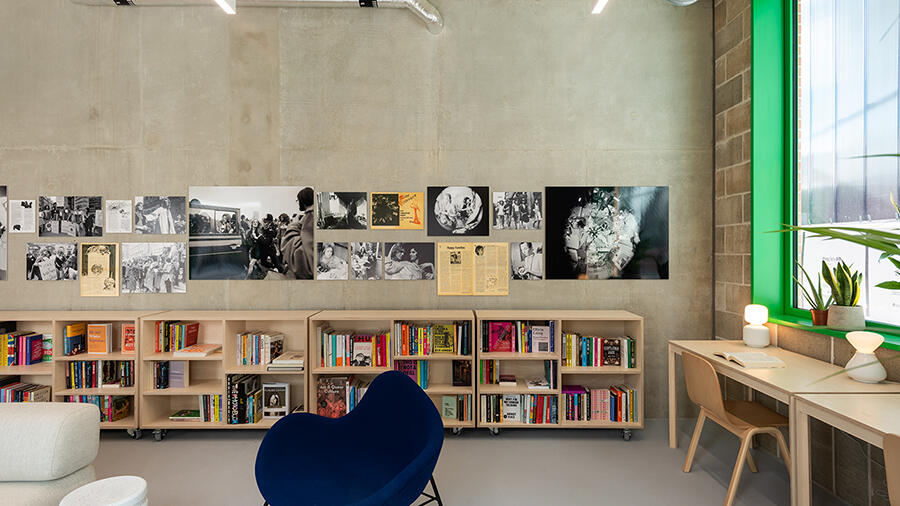Queercircle Establishes a Space for London’s LGBTQ+ Artists
Sean Burns visits a nascent gallery that is fast becoming a champion of intersectional voices from across the capital
Sean Burns visits a nascent gallery that is fast becoming a champion of intersectional voices from across the capital

London's emerging artists and gallerists have long contended with rising rents and a diminishing number of spaces. In this dossier, frieze profiles four new galleries — HOME, Ginny on Frederick, Guts Gallery and Queercircle — that are cultivating communities and flourishing amidst the city's many challenges.
In London, as in most major cities, rapid gentrification and escalating real-estate prices in recent years have led to a dearth of affordable spaces for creative enterprises. Transpose this to a queer context and you encounter some terrifying metrics. As Ashley Joiner, founder of non-profit Queercircle, stated in an online interview with Design District Journal earlier this year, more than 50 percent of London’s LGBTQ+ spaces have closed in the past decade. With these ideas of scarcity and equity in mind, he established Queercircle as a charity in 2021, oriented at supporting and celebrating queer artists, curators, organizers and thinkers.
Queercircle existed as a website and residency platform, somewhere between a magazine and billboard, for one year before the opportunity of converting the project into a physical space arose in 2021. The new permanent gallery and library reside in the Design District, a Thameside development of commercial, non-profit and residential lots in Greenwich. It’s fast becoming an exciting resource for the city’s LGBTQ+ creatives.

When I visited Queercircle in June, the library room – well-stocked with writers from Radclyffe Hall to Stuart Hall – displayed ‘The Queens’ Jubilee’, an exhibition of photographs from Come Together (1970–73), an early Gay Liberation Front (GLF) newspaper. It was the most serene I’ve felt in a long time, in a city where you so often have to pay to be somewhere. Co-curated by Joiner and GLF activist Stuart Feather, the images of 1970s GLF political actions proposed a pertinent connection between current and historical equality struggles. In the main gallery, a succinct wall text introduces Michaela Yearwood-Dan’s Let Me Hold You (2022), an exuberant wall painting containing swathes of greens, reds and yellows beside references to natural forms. Joiner’s selection of Yearwood-Dan to inaugurate Queercircle demonstrates a nous for the city and the scene. It’s a fitting explosion of spirit.

The prospect of a gallery infused with queerness is not without precedent: New York has Leslie-Lohman Museum of Art; Berlin has Schwules Museum. Queercircle also joins Queer Britain, a dedicated museum of LGBTQ+ history, which opened earlier this year in Granary Square, north London, next door to Central Saint Martins. Founding a space around the rubric of queerness is undoubtedly tricky because the terminology, by nature, ought to remain elusive and porous. How that translates into an organization with a fixed director and board of illustrious trustees – including artist Isaac Julien and actor Russell Tovey – will always be a negotiation of interests. Joiner will have to stay reactive and open to change to keep up with the shifting needs of Queercircle’s namesake communities.

With queer identities increasingly co-opted for consumerist ends, queer folk must have access to resources outside the spectre of profit. As the US senate begins to repeal hard-fought rights – including Roe vs Wade, which protected universal abortion access – it’s more urgent than ever that we bolster the generations of work that enabled such freedoms to exist and continue to support those they protect, including the LGBTQ+ community. Queercircle’s inaugural programme explores ideas of ecology and its political intersections with queerness, including the forthcoming solo show by bones tan jones. An array of conversations, walking tours, workshops and meet-ups run concurrently, addressing topics as wide-ranging as sci-fi queer ecologies with artist Adham Faramawy and the art of suminagashi (Japanese paper marbling) with the founder of Bōk Bindery, Sam Petherbridge.
Well-meaning grassroots organizations and charities must work in diverse ways – through loop-holes and in collaboration with planners, funders and developers – to make art happen in a metropolis obsessed with real estate, where every square centimetre has a price. That said, we need doers, community leaders and proactive curators, such as Joiner, to cater to the burgeoning needs of complex communities. The idea of occupying space will always be a negotiation; it’s what you do with it that counts.
This article first appeared in frieze issue 230 under the dossier headline ‘New Kids on the Block’.
Main image and thumbnail photo: Guy Bolongaro

























